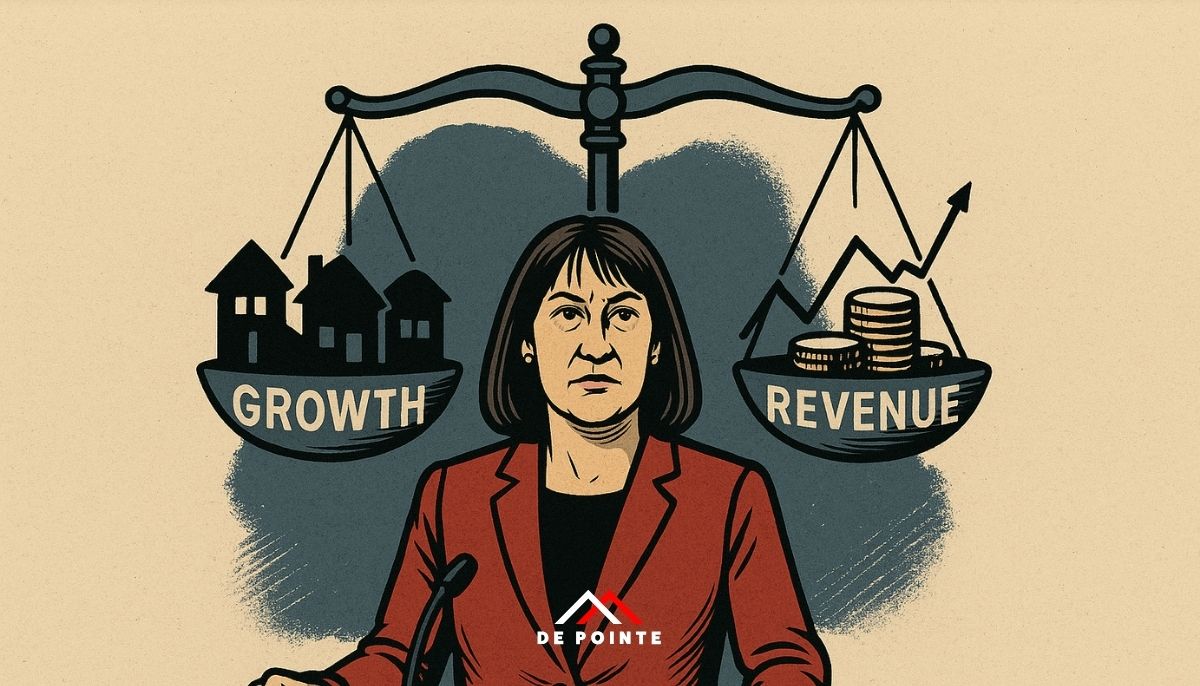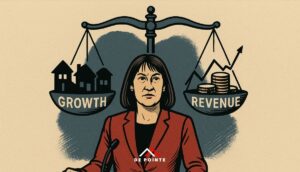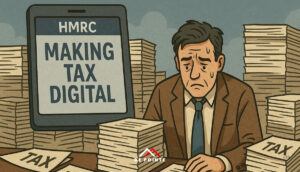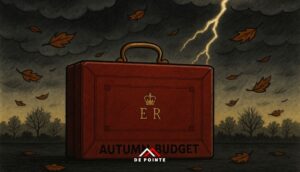Article

When Rachel Reeves stepped into 11 Downing Street as Chancellor, she inherited much more than a fancy office. She inherited a public finances with structural challenges: elevated debt, weak growth, rising interest burdens, and the legacy of fiscal instability.
Now, as she braces for the Autumn Budget, Reeves must walk a razor’s edge: raising revenue while preserving growth, maintaining credibility with markets, and holding to some of Labour’s key pledges (notably: no increases to VAT, income tax or national insurance for “working people”).
The Fiscal Imperative: A Rough Estimate of the Gap
Multiple observers now estimate that Reeves will need to find £20 billion to £30 billion (or more) in “hard choices”, either via tax increases, spending reductions, or a mix of both, to plug a projected fiscal shortfall and stay within her own budgetary rules.
That’s a big ask, especially when growth forecasts are being trimmed and borrowing costs remain high.
If Reeves fails to deliver credible revenue underpinnings, the market and rating agencies may demand more draconian adjustments later — or punish the government’s borrowing costs.
Key Tax Areas Under the Spotlight
Here are the taxation arenas likely to be reshaped or repriced under Reeves’s Autumn Budget:
|
Tax Domain |
Possible Moves / Proposals |
Risks & Trade-offs |
|
Wealth & capital taxation |
Reeves has already signaled that “higher taxes for the wealthy will be part of the story.” Considerations include raising capital gains tax, taxing unearned income (dividends, interest), or revisiting reliefs and exemptions. The IFS warns that heavy-handed increases on returns to capital may damage investment incentives. |
If rates rise too far, the danger is capital flight, disincentives, or complex avoidance. Also politically sensitive: perceptions of “taxing success.” |
|
Property and housing / real estate taxes |
Some proposals include replacing or reforming stamp duty, introducing more progressive property taxes (e.g. tax on land value or second homes), or applying national insurance on rental income. |
Property is a politically fraught space. Residential property taxes hit many middle-class voters; rapid reform invites pushback. |
|
Inheritance tax (IHT) & agricultural assets |
Changes are already underway. The October 2024 Budget introduced IHT on rural / farm estates valued over £1 million, at 20% (half the standard rate), removing exemptions for agricultural property relief. In advance of the new Budget, ministers are reconsidering easing the burden for farmers. |
This reform has spurred sustained protests from farmers who argue that they are asset-rich but cash-poor, risking forced land sales. Adjusting this measure may lessen revenue but may be politically necessary. |
|
Professional / service sector taxation |
There is speculation about extending national insurance (NI) or specific levies to partnerships or professional services (e.g. GPs, lawyers) that currently benefit from reliefs. |
Targeting narrow sectors risks being portrayed as unfair “raids” and may raise legal or behavioural pushback (e.g., restructuring, reclassification). |
|
“Sin taxes” and narrower levies |
In the hunt for marginal revenue, Dalton-style options like higher taxes on gambling, tobacco, alcohol or environmental levies may appear. |
These are less distortionary in theory, but hit specific groups hard. For example, gambling firms warn that higher taxes could force closures. |
|
ISA / savings allowances |
There is speculation that the “cash ISA” allowance could be reduced to bring more returns on savings into the tax net. |
This would particularly bear on savers, retirees and middle-income households who rely on tax-efficient wrappers. Political blowback is a risk. |
The Political & Growth Constraints
Reeves is constrained not only by arithmetic, but political credibility:
- Pledges not to hike income tax, VAT, NI on working people: Labour has promised to hold those lines, meaning much of the burden must fall elsewhere.
- Avoiding “austerity 2.0” narratives: She’ll need to manage optics so that revenue-raising doesn’t read as a return to harsh cuts.
- Economic growth: She needs to avoid tax policy that chokes growth just when productivity is languishing. The IFS cautions against raising capital-related taxes without structural reform.
- Credibility with markets: The fiscal plan must be credible and sustainable. A budget seen as gimmicky or opportunistic could spook bond markets and raise borrowing costs.
- Internal party unity: Labor backbenchers (especially in rural or middle-income constituencies) may revolt against heavy taxes on “wealth” or professions.
What This Means for Stakeholders & Voters
- High-net-worth individuals and investors will face greater scrutiny and potential tax burden increases, especially in areas of capital gains, dividends, property or unearned income.
- Farmers / rural estates are caught in the crosshairs: the inheritance tax changes risk destabilising intergenerational transfers unless concessions are made.
- Professionals and partnerships should monitor whether NI or new levies will implicate them.
- Middle-income savers could feel squeezed if ISA allowances are reduced or tax-efficient wrappers reined in.
- Businesses and the corporate sector will watch for changes in property taxes, levies on financial services, or adjustments to reliefs.
Strategic Focus for De Pointe Research & Clients
- Scenario modelling: Run tax-sensitivity models across alternate tax packages (e.g., heavier capital gains vs heavier property tax) to see impact on asset classes, investor behaviour, and migration.
- Policy lenses: Stress-test proposals through efficiency, equity, simplicity, growth and compliance burdens. Not all revenue-raising is equal, some is more damaging or distortionary than others.
- Stakeholder mapping: Identify constituencies for backlash or support (agriculture, real estate, professional services) and craft narrative / communications accordingly.
- Timing and signaling: Pay attention to OBR forecasts, “jawboning” from Reeves in advance, and gradual implementation phases, phasing may reduce shock.
- Contingency buffers: Plan for downside risk (e.g. a weaker growth or unexpected recession) in case tax yields come in short of projections.
Final Thought: Tax Reform Over Tax Increase
In many ways, members of the economics community argue that reform matters more than rate increases. The IFS has warned that simply raising rates on capital returns or windfall sectors without structural reform risks damaging growth and investment.
The Autumn Budget is not just a revenue exercise, it’s a test of Reeves’s ability to design a tax system that is fair, growth-friendly, credible, and politically sustainable. How she distributes the burden, across property, wealth, capital, professions, savings, will define not just the next financial year, but the shape of the UK economy for years ahead.






